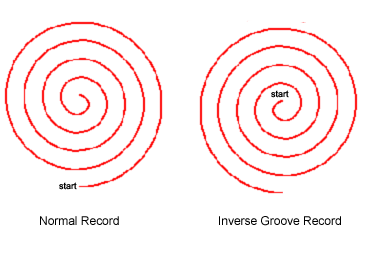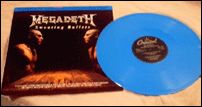Response to the vinyl manufacturing saga thus far, from Sarah:
“Get a room, man! ENOUGH’S ENOUGH.”
With that in mind, I present yet another installment.
Another fun trick that can be employed while cutting the master
plates for a vinyl release is the inverted groove – that is, a record that plays from the inside out. Since the direction in which a standard turntable ‘turns’ to plays a record is not reversible (Without human intervention), the direction of the grooves is reversed.

This practice appears to have practical origins in radio and soundtrack applications. Radioarchives.org is a site dedicated to preserving first generation copies (ie vinyl) of early radio programming. Some choice bits in the way of explanation from their site:
“During the golden age of radio, programs were generally recorded on 16″ disks. Some were recorded during a live broadcast; others were pre-recorded for distribution to local stations. Since the concept of repeating a recorded broadcast didn’t really take hold until the early 1950s, many of these recordings were not retained once they had been played for reference purposes.”
Apparently inside-out records used to be common for radio shows distributed on 16″ vinyl, as many are labeled “start outside” or “start inside”. Some theories on why this was done, culled from the newsgroups:
“I would guess that it is easier to
cue;
you drop the needle into the wide band in the middle rather than a thin
strip
on the
edge. Also, it would be easier to watch for the end of the record.”
Records with inverse grooves were also used to accompany silent films. Details from this newsgroup thread:
“Yesterday, I went to a movie at one of the few remaining old-time
movie
houses, you know, the kind with only one screen with a curtain, a
marquee
over the entrance, and a bubble-like ticket window on the outside.Anyway, inside the theater, they had some display cases containing old
cinema artifacts. One of these was a 15-inch record that was used as a
soundtrack to a 1920s movie — not a movie soundtrack in today’s sense
(e.g. “I got the soundtrack to Titanic”), but the actual audio
component to
a movie being played. This was how it was done in the days before sound
was encoded on the film itself, and yes, sometimes the record got
annoyingly out-of-step with the film.I took a close look at this ancient record, and I noticed that there
was no
spiral on the lead-in area. Rather, there appeared to a single
lock-groove
around the perimeter. Then upon looking at the lead-out area, not only
did
the penultimate groove come to an abrupt tapered end, but the word START
was carved on the vinyl at that point. It therefore appeared that the
record was designed to play backwards, or from the inside out.Were inside-out records common back then, for that or other purposes? I
did hear that there are a number of novelty records being made that way
today, but with caution that they wreak havoc on modern tracking
systems.
Could one reason for using inside-out records in movies be that, with
the
assumption that outer tracks sound better than inner tracks, it saves
the
best quality sound for last?”
The only reply that this post garnered was the following:
“Sixteen-inch transcriptions were done in the days before hot-stylus
cutting, so audio that was crisp and clear at the edge of a 33 1/3 rpm
record would become muddy and muffled near the label. Therefore,
transcriptions were usually done alternating outside-in for side 1,
inside-out for side 2, outside-in for side 3, etc. This meant that the
sound quality would change gradually over a 30 minute cycle, rather
than a
jarring difference every 15 minutes when the record sides switched.”“Another reason for inside-out records was that they required less
babysitting while being cut. The chip cut from a lacquer has a tendancy
to
drift towards the center. If the record runs from the outside in, the
operator has to sit there and constantly brush the chip away from the
approaching cutting stylus. If it’s cut inside out, the cutting stylus
is
moving away from the chip, and the operator has one less thing to worry
about.”“In the ’50s, hot-stylus cutting and chip suction came along and made
both
of these issues moot points. Of course, they came with their own set of
problems, but that’s a different story…”
There are a few contemporary releases I’ve managed to track down that use this technique, though many of them are no less obscure than the transcription records.
- Blur’s promo-only 10″ version of ‘Tender.’ Adding to confusion is the fact that there were two promo 10″ versions of Tender – one with backwards grooves and one that came sealed in a silver bag.
- Certain pressings of Throbbing Gristle’s ‘The Second Annual Report’ have one side that plays backwards.
-
The Checkpoint Charlie ‘Salz & Phiffer’ EP, which is actually by Mark Volman and Howard Kaylan (AKA Flo and Eddie, formerly of The Turtles) has inverted grooves, with a warning on the
cover in both German and English “Warnung: Diese Platte ist nur von innen nach aussen Abspielbar” and “Warning: This record plays inside out!” - In 1979 Mercury Records released a sampler called ‘Counterrevolutionary Music: 33 1/3,’ including songs from the Scorpions, John Cougar, and others.
- From a techno newsgroup: “On Circuit Breaker’s – “Experiments in Sound”-EP one side runs on 45 completely backwards (“When this song ends, so will your needle”) and the other side, which runs on 33, has two tracks. The outer track runs “forwards”, the inner one “backwards”, so both stop in the middle (Not in the centre of the record, but the middle of the playable vinyl area; if you had two needles, they would run
towards
each other). They did the same thing
with their “Overkill/Frenzy” single. It’s a bitch to
figure out which one is which when you’re spinning in the dark.” - Certain pressings of Megadeth’s Sweating Bullets 12″ single were pressed on baby blue vinyl that plays backwards.

There are also countless hardcore bands who have done this on one 7″ or another, but all the imformation I’ve turned up using google has been pretty vague. If you know of one, let me know.
Also: ‘Inverted Groove’ would be a good name for a funk band.